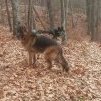Leaderboard
Popular Content
Showing content with the highest reputation on 02/02/2023 in all areas
-
2 points
-
Well isn't this guy a real piece of work... I exist so I's ain't fraudulent (Hiflier's even seen me), and I's made no claim that can be declared likewise. You on the other hand are out the gates as a feckineejit. I take no offense, you shouldn't either, welcome to the club.1 point
-
I ain't either but I'm not giving up title of best hunter to that Brigand. You ain't never seen me hunt so how would you know?1 point
-
1 point
-
1 point
-
ETA. Actually, ignore that question. I don’t really care. Please continue. Might I ask why you consider me an “absolute fraud”? Have you and I ever discussed my personal approach to the subject?1 point
-
For those interested in using drones for BF research, I recommend that you listen to this podcast interview of Robert (Rob) Evans by Cliff Barackman. I found it interesting and learned a few things about what BFRO was and is doing with drones. I did not know who Rob Evans was before I listened to this interview. He is one of the folks who operated and supported the drones used during the Finding Bigfoot TV show and has been a long time supporter of BFRO and its drone research program. He worked for Microsoft for 22 years and while he lived in WA he conducted his own private BF research. He is now retired from MS, lives in Florida, and has his own drone company to support wildlife research. https://bigfoot-and-beyond-with-cliff-and-bobo.simplecast.com/episodes/ep-167-rob-evans-drone-squatching-0mk9sVHF While not drone related, he mentioned at ~ 35 min, that while providing software support to Universities that where doing wildlife research with a network of game cameras (software that he developed privately for identifying the type of wildlife captured by the camera using AI), that the universities had captured photographs of BF taken during animal monitoring research. However, these universities where not willing to share these photographs to avoid controversy and ridicule. I find it strange that wildlife biologists would hide photographic evidence, unless the photos were ambiguous and blobsquatches that had no evidentiary value. He provided some guidance for folks who want to enter into the drone research. His recommendations for Drones are as follows: Low Range: < $2,000 Parrot Bebop Yuneec H520 Nonetheless, Rob does not recommend the low price drones because they are too low end on performance and thermal imager is low resolution. Instead, he recommends that research teams pool their funds and go for the mid range. Mid Range: $6,500 to $10,000 depending on accessories and extra batteries purchased DJI Mavic 2 Enterprise Advance (has 640 x 512 px thermal camera) High Range: $20 to $30 K DJI Matrice 300 RTK This is the one he owns. At the end of the show, Cliff says that he does not use drones and mentions some of the negatives. - it is very stressful (safety issues and the required attention to controls, drone location, and situational awareness) - it is complex (you need FAA drone pilot license). Although some folks might get by with a non-commercial permit if their intent is just recreational and then just have to take the UAS Safety Test and register their drone. But any YouTube video posted that is using drones and is generating revenue is considered non-recreational (and thus commercial) and needs the FAA drone pilot license. (I could be wrong on this, but that was my interpretation after reading the FAA guidelines in https://www.faa.gov/uas/recreational_flyers ) - it is expensive and you need insurance (if you lose the unit or if you hurt people with it) I lean towards Cliff's position on avoiding more technology in the field. I rather investigate the night close to camp with a thermal imager. But, I fully understand that this technology offers great opportunities to wildlife capture. Maybe best to wait for less noisy, longer battery life, and cheaper units in 5 years.1 point
-
Hello everyone! New member from Kentucky. Hope to see some interesting pics and videos of the mysterious elusive bigfoot.1 point
-
The hibernation question brings up the extremes of their reported habitat. The farther north and away from tidewater you go, the more hibernation is required. Even if we accept meat caching for winter like modern man (circa 4500 years ago to today), that would mean a semi-hibernation existence in the far north interiors. Not so the coastline. The sea provides year round sustenance.1 point
-
You have to back up and consider all of the assumptions that you've made here. Yes, Ketchum assumed that their cleaning techniques were adequate to remove any human contamination - but as should be clear from Dr. Hart's analysis, that assumption is simply not true (and if it were, her team would be perhaps the only one ever in the history of genetics research to 100% filter out non-target DNA prior to analysis). You're also assuming that these mutations came from the same genome; they may not have at all. As Hart notes on p.37 of his book, the study's supposedly "whole genomes" alleged to be of the same species had wildly different numbers of bases (one of the nuclear sequences was nearly 5 times another!) Contamination from a common source (e.g., a human or even multiple humans working on the project) is certainly possible. I saw elsewhere where you distinguish between "Ketchum's interpretation" and "Ketchum's DNA." Fair enough to an extent. Her interpretation has been proven to be wrong. Her raw sequences, however, are certainly suspect - and seem to show obvious signs (both to Haskell and to me) of not having been produced in the ways that she claims they were (for example, the study doesn't mention how each sample was primed; her later claim that only universal primers were used doesn't seem to match up with the data or the typical protocols of the external labs that were used). Lastly, while these mutations may be rare right now in Genbank, we have to consider Genbank's limitations. There is a current effort (https://www.theguardian.com/science/2023/jan/29/the-human-genome-needs-updating-but-how-do-we-make-it-fair) to get data in from populations that are woefully underrepresented; it may be that these mutations (nor their co-incidence) are that rare at all in a certain human population. The above are just a few reasons why the jury must still be out on any special significance that Haskell's observation might have. Again, I agree with him that it is a fantastic question to investigate, but it cannot even begin to be answered without more (and more trustworthy) data.1 point
-
We do all that work, put in all that time, then as a member and core member of this forums SSR team, i share it in a thread titled 'seasonal migration?' and you reply with that AFTER editing (i'd pay to see what you posted before editing) ? Seriously ? Beyond this, you're not even worthy of a reply.1 point
-
Careful there, 7.62, you're starting to sound almost as frustrated as I am in trying to make sense out of what other people do. And those very people have the gall to keep charging money for little to nothing in return. Or whatever passes for a return is returned to a bar set so low by attendees and novices that I could throw a rock unseen into the brush and freak everyone out: "It's BIGFOOT!" That's how low the bar is set on Finding Bigfoot as well- if not lower. It's a real shame. Shame on them! But yeah, Bigfoot activity without the foliage screen but in winter with good visibility and the possibility of snow tracks? It's a win/win. Oh, and then there would be DNA possibilities- which never gets brought up on Finding Bigfoot, though I've yet to view even a single episode myself in all these years so that may or may not be true since Ms. Hollander is the scientist on the team. P.S. It's why I do my research in winter....nothing so far to report. Animal tracks galore everywhere, though. So....about that hibernation thing....1 point
-
You know another thing that really bugs me is the paid expeditions that BFRO does and claims many have encounters that have rock throwing, knocking or they hear them close by . If they want to be so sure they are Really having encounters have them in the snow not during the summer months . Listen we hear knocking from the guide ! that's a Bigfoot we are sure ! or just had a rock or stick thrown ! Yup Bigfoot ! Well do it during the months the people can walk in the area and show the tracks in the snow where these guides say it was a Bigfoot .1 point
-
This website has a plethora of old cryptozoology newsletters. I hope you find it useful. http://www.strangeark.com/cryptozoology-resources1 point
-
These are from the 90's, but there are a bunch of "Track Record" newsletters at archive.com that may be worth reading through. https://web.archive.org/web/20041011000259/http://www.internationalbigfootsociety.com/html/the_track_record.php A bunch of "Track Record" encounters are in the John Green database, and highlighted on this forum in the John Green SSR section. You can go to https://bigfootforums.com/forum/160-john-greens-sightings-database/ and enter the search term track.php to find them.1 point
-
The only one in that group that I couldn't call an absolute fraud is Norseman... There's only one way to prove Bigfoot exists and 99% of supposed researchers aren't even willing to consider doing it. That's why bigfoot "research" is a joke.0 points
-
Another thing was the show finding Bigfoot . I would venture to guess 99% they never ventured out in the snow looking . Always in warmer months . They claimed many times watching the show they heard something that was Bigfoot , Well if there was snow you could walk and find tracks of what you say was a Bigfoot.-1 points
-
-1 points
This leaderboard is set to New York/GMT-04:00











